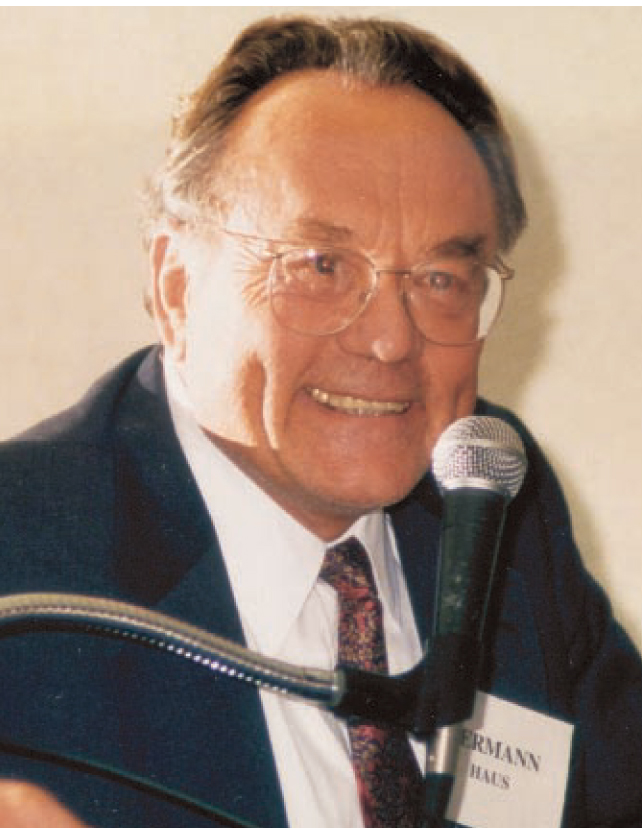Hermann Anton Haus
DOI: 10.1063/1.1712509
Hermann Anton Haus, a prolific contributor to emerging technologies in optics for more than 50 years, died on 21 May 2003 of a heart attack at his home in Lexington, Massachusetts, following his routine bicycle commute from MIT.
Hermann was born in Ljubljana, Slovenia, on 8 August 1925. When the Communists expelled the German-speaking population from Yugoslavia shortly after the end of World War II, Hermann and his mother were taken from their home in the middle of the night and shipped by rail to Austria with other refugees. On the refugee train, he met a chemist who had lost a lifetime’s worth of notes. Then, Hermann said, he realized that the only thing you can count on is the knowledge you carry in your head. That realization inspired his love for elegant theoretical descriptions that he could derive from basic principles, and his insistence on giving his classroom lectures without notes.
After beginning his university studies in Austria, Hermann wrote to General Mark Clark, commander of US forces, to ask for help in getting to the US. According to Hermann, his English was passable at that point. He had learned it by reading Gone With the Wind. After attending the Technical University of Graz and the Technical University of Vienna, he came to this country and received his BS from Union College in Schenectady, New York, in 1949. In 1951, he was graduated from Rensselaer Polytechnic Institute with an MS in electrical engineering and came to MIT, where he earned his DSc in the same field. His thesis research, under L. J. Chu, focused on the propagation of signals and noise along electron beams at microwave frequencies.
Hermann joined the electrical engineering faculty at MIT in 1954. He was promoted to associate professor in 1958, to professor in 1962, to Elihu Thomson Professor in 1973, and to Institute Professor in 1987.
The study of noise was an early and recurrent theme in Hermann’s research. In his graduate work and as a young professor in the 1950s, Hermann investigated noise in microwave traveling wave tubes and other electronic amplifiers, obtained simple formulations for optimum performance, and, with Richard Adler, established the concept of “noise measure.” In the 1960s, shortly after the invention of the laser, he extended his studies to quantum systems, and he and James Mullen showed that the noise power in a single mode amplifier, with gain G and bandwidth B, had to be greater than (G – 1)ℏω 0 B. With Charles Freed, he carried out the first experimental observations of quantum noise in a laser oscillator by showing that the photon statistics in a helium–neon laser changed from degenerate Bose–Einstein below threshold to Poisson above.
In the 1970s, Hermann produced his seminal and definitive analyses of modelocking, the process by which short pulses are generated in lasers. His “slow absorber” theory provided the basis for the description of dye laser systems that produced the first subpicosecond pulses and for his demonstration of the picosecond modelocked semiconductor diode laser. His “fast absorber” theory, which he developed to describe early solid-state laser experiments, has become—with its extension to additive pulse modelocking and Kerr lens modelocking—the basis for analyzing present-day femto-second lasers. Hermann also began a series of significant accomplishments in integrated optics: He produced original analyses of waveguide coupling, invented the quarter-wave shift for distributed feedback devices, and invented and demonstrated the nonlinear waveguide Mach–Zehnder switch for ultrafast all-optical logic.
Hermann returned to the subject of noise in lasers and in optical fiber transmission systems during the 1980s. With Jim Gordon, he showed that quantum noise introduced by optical amplifiers places a limit on the long-distance transmission of solitons by causing timing jitter (the Gordon–Haus effect), and then, with Antonio Mecozzi, showed that the limitation could be overcome with the use of filters. In the early 1990s, with his student Yinchieh Lai, Hermann first developed theories for soliton squeezing and the quantum fluctuations of solitons.
The importance of Hermann’s pioneering work became increasingly evident in recent years. He remained at the forefront of progress in the field. With students and colleagues at MIT, he carried out dramatic demonstrations of the squeezing of vacuum fluctuations in optical fibers and, in 2001, achieved signal noise reduction to as much as 6.1 dB below shot noise. He invented novel modelocked fiber lasers and provided theory for the operation of less-than-two-cycle pulse lasers. He pioneered the development of compact, high-index-contrast photonic circuits and cowrote the book Passive Components for Dense Optical Integration (Kluwer Academic, 2002) with Christina Manolatou. In a matter of months, he wrote his 560-page book Electromagnetic Noise and Quantum Optical Measurements (Springer, 2000) to present a unified description of classical and quantum noise. Of his more than 380 journal publications, he wrote an astounding 200 after age 65.
Hermann received many prizes and honorary degrees and was elected to both the National Academy of Engineering and the National Academy of Sciences. An immigrant who was deeply grateful for everything this country had permitted him to achieve, Hermann was particularly proud to receive the National Medal of Science from President Bill Clinton in 1995.
Hermann was an enthusiastic and devoted teacher. During each of the last six decades of his life, he taught both undergraduate and graduate courses, inspiring generations of students at every level. At the same time, he taught all of us—colleagues, students, and friends—about much more than science. We were awed by his command of literature, history, and language, and by his energy. He biked to and from work every day. He led us on long hikes and across-the-lake swims. We followed him to lectures on the cosmos, to local museums and art exhibits, and on his tour of campus sculpture. His door was always open and he always had time for us. He was a great colleague, mentor, and friend.

Hermann Anton Haus

More about the Authors
Erich P. Ippen. Massachusetts Institute of Technology, Cambridge, US .
